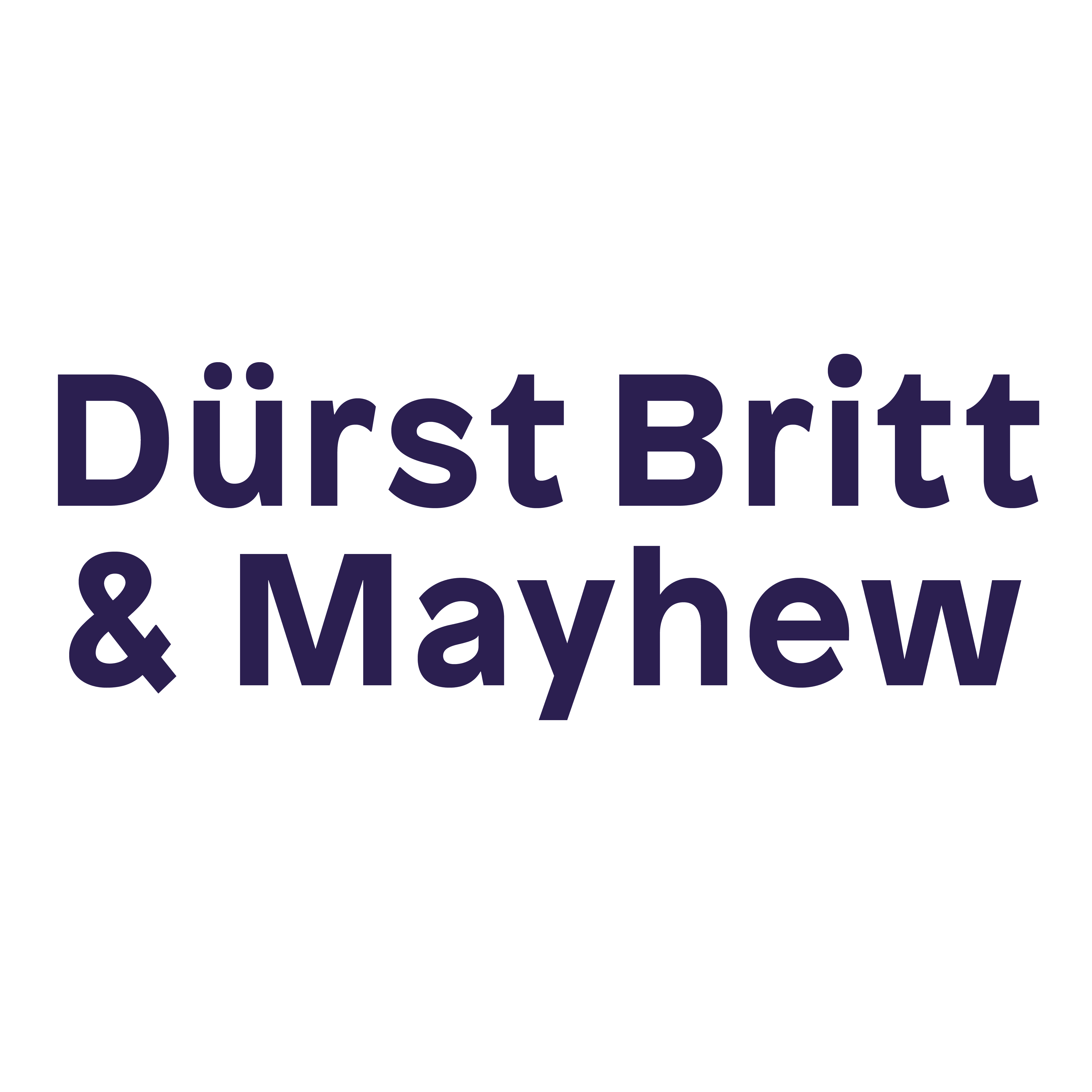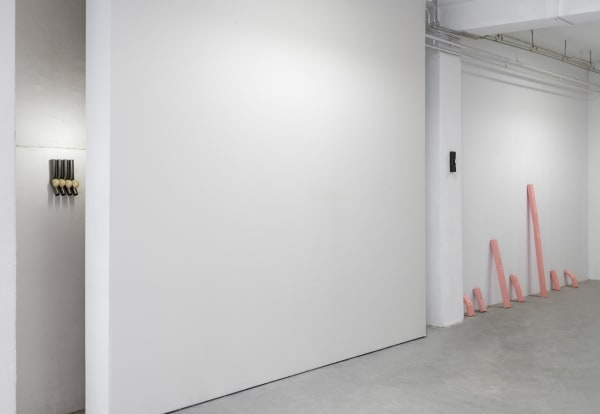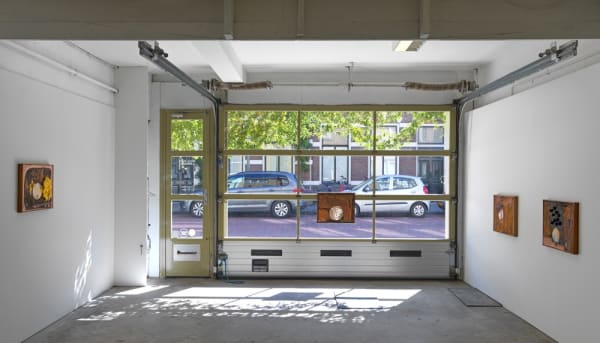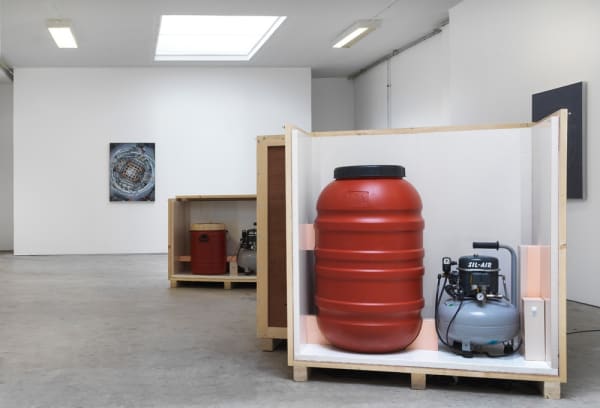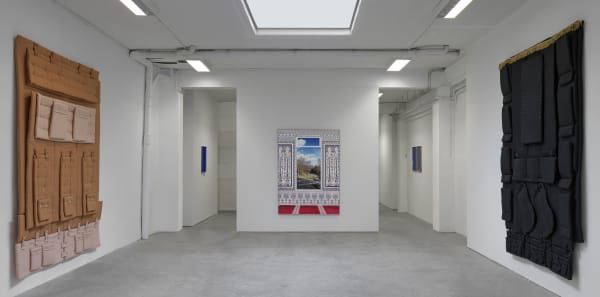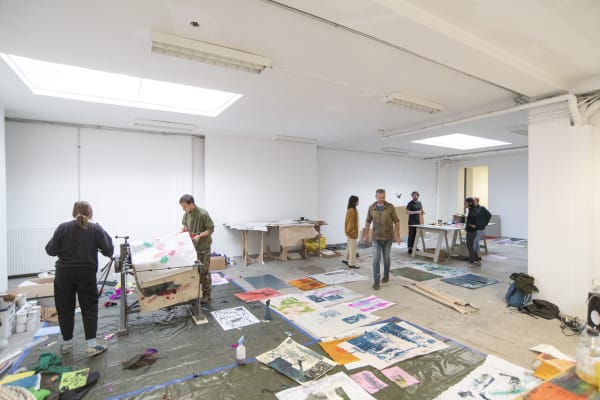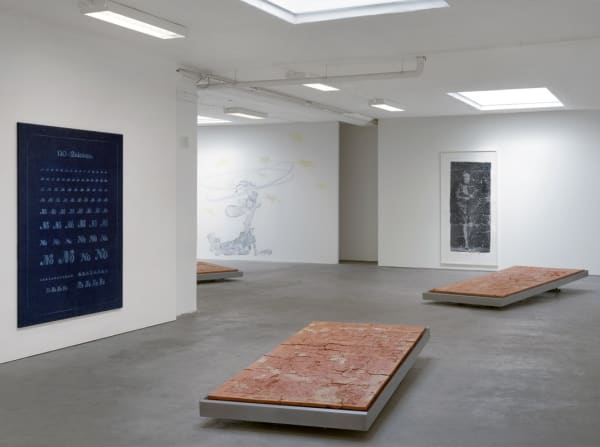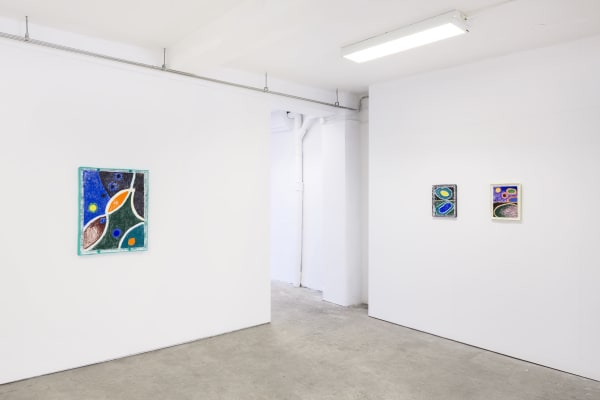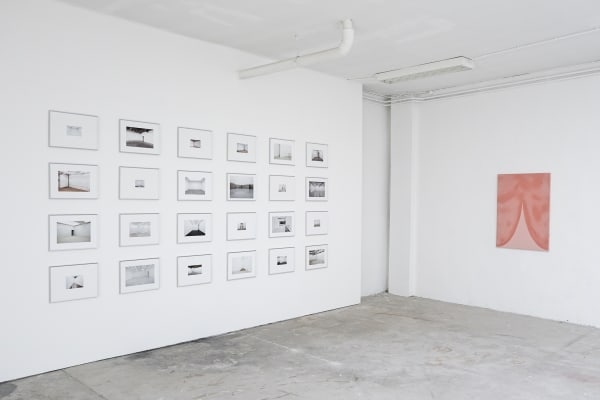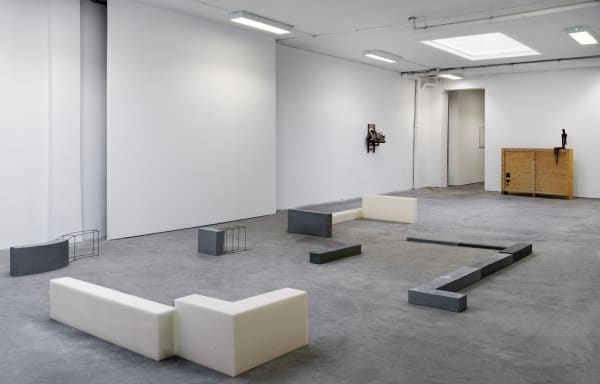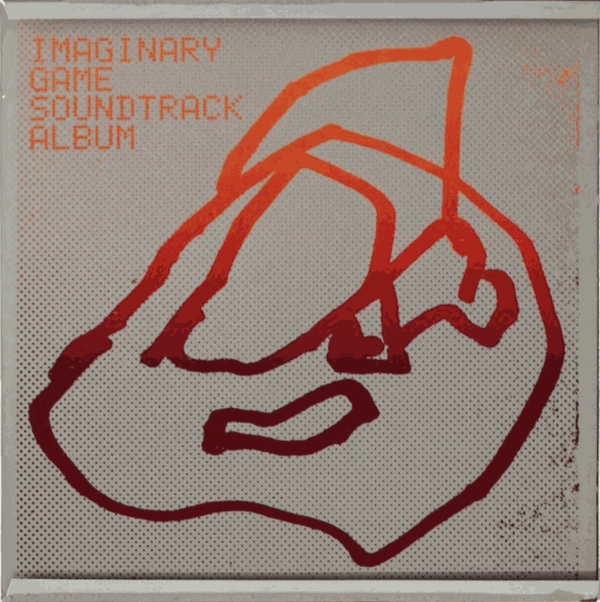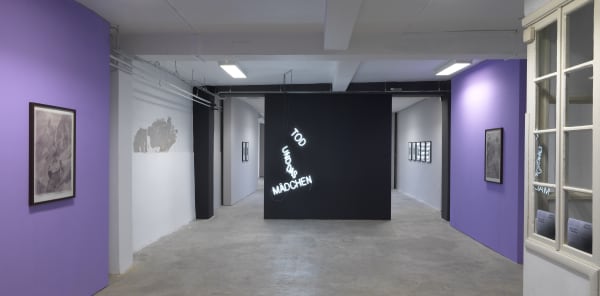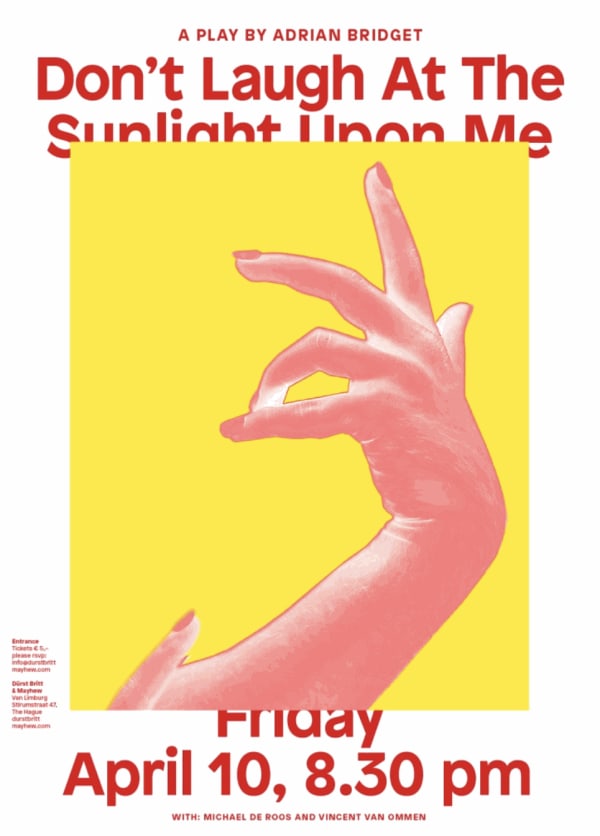Past
-

Maja Klaassens
A Line of Stones 18 Apr - 8 Jun 2025 Dürst Britt & Mayhew is proud to present 'A Line of Stones' by Maja Klaassens . After her presentation in the Frontspace in 2022 this is the first exhibition since the gallery started representing her in 2024. In her new body of work, Maja Klaassens explores the function of editing... Read more -

Henk Peeters (1925-2013)
Frontspace 18 Apr - 8 Jun 2025 Dürst Britt & Mayhew is proud to present a selection of works by Dutch artist Henk Peeters (1925-2013). Peeters was the most active member of the Dutch Nul group; he made the international contacts, organised the international ZERO (Nul) exhibitions at the Stedelijk Museum Amsterdam, and wrote on the theory... Read more -

Jacqueline de Jong (1939-2024)
Seven decades 24 Nov 2024 - 5 Apr 2025 Dürst Britt & Mayhew is pleased to present ‘Seven Decades’, Jacqueline de Jong ’s fourth solo exhibition with the gallery, bringing together works from every decade since she started her artistic practice in the 1960s up until her final works. In the intervening decades De Jong experimented with a range... Read more -

Lennart Lahuis
Frontspace: Pockets of Memory 24 Nov 2024 - 5 Apr 2025 After Lennart Lahuis ’ successful solo exhibition ‘Earth Fire Water Air’ at Museum Schloss Moyland in Bedburg Hau, a solo booth at Art Düsseldorf, and our collaborative presentation at Galerie Britta Rettberg in München within the framework of Various Others, Dürst Britt & Mayhew is happy to premiere a selection... Read more
-

Willem Hussem
Though I'm seventy I still plant trees 31 Aug - 10 Nov 2024 Dürst Britt & Mayhew kicks off the new season with a solo exhibition by renowned Dutch artist Willem Hussem (1900-1974). The exhibition focuses on works from the early 1970s, the last period of Hussem’s artistic life, in which his vocabulary changed from lyrical constructivism to a very personal adaptation of... Read more -

Paul Beumer
Pilgrim discovering another world 28 Apr - 14 Jul 2024 For his fourth solo exhibition at the gallery Dürst Britt & Mayhew is proud to show a selection of textile works by Dutch artist Paul Beumer. This selection consists of works from when the artist first traveled to Asia in 2015, up to now. The exhibition will not so much... Read more -

Wieske Wester
The artist is not here, she is picking feathers 18 Feb - 20 Apr 2024 Wieske Wester ‘s solo exhibition ‘The artist is not here, she is picking feathers’ focuses on still life imagery of a life lived in the countryside. Objects close to kitchen or garden are turned into images that hover between figuration and abstraction. Painted in her well known impasto, the cool... Read more -

Alejandra Venegas, Willem Hussem
Frontspace: my shadow chases the butterfly to another flower 18 Feb - 20 Apr 2024 The duo exhibition ‘my shadow chases the butterfly to another flower’ presents a transhistorical dialogue between recent woodcarvings by Alejandra Venegas and woodcuts from 1924 by Willem Hussem (1900-1974). Alejandra Venegas hand carves landscape scenes and natural motives from various sorts of wood native to Mexico, after which she colours... Read more
-

David Roth
Labour and wait 18 Nov 2023 - 3 Feb 2024 ‘Labour and Wait’ is David Roth ’s third solo exhibition at Dürst Britt & Mayhew. The exhibition brings together various distinct bodies of work, which continually play with concepts of construction and deconstruction as well as with the performative and sculptural potential painting can possess. The first room of the... Read more -

Raúl Ortega Ayala
Montserrat (a phono-archaeology) 2 Sep - 29 Oct 2023 For his second solo exhibition at Dürst Britt & Mayhew Mexican born artist Raúl Ortega Ayala presents a series of photographs he took on the Caribbean island of Montserrat. The island has a long colonial history, but in the 20th century turned into a vacation destination mostly for British citizens... Read more -

Daniel Cabrillos Jacobsen
Frontspace: Moonlight bunny napping 2 Sep - 29 Oct 2023 Daniel Cabrillos Jacobsen is a recent graduate from the Royal Academy of Art in The Hague. Combining his Danish and Filipino background, he approaches painting with a colourful and intuitive style that reflects his dual cultural identity. His works not only celebrate his heritage but also draw inspiration from the... Read more -

Jacqueline de Jong
Frontspace: Border…and other Lines 3 Jun - 16 Jul 2023 Jacqueline de Jong’s third solo exhibition at Dürst Britt & Mayhew brings together a series of large-scale paintings made between February 2022 and May 2023. ‘Idlib in Snow’, a painting completed at the beginning of 2022, marks the transition from a series of works about one catastrophic event, the refugee... Read more
-

Bram De Jonghe
Frontspace: Long story short 16 Apr - 21 May 2023 Dürst Britt & Mayhew is proud to present Bram De Jonghe ‘s first solo exhibition at the gallery. De Jonghe relates to his surroundings like a sculptor. His spatial interventions respond to the (exhibition) space: to imperfect architecture, to the so called neutrality of the white cube, or to the... Read more -

Alexandre Lavet
(、ン、) (second version) 19 Feb - 16 Jul 2023 Alexandre Lavet’s work constantly seems to hover on the verge of presence and disappearance. He plays with the apparent homogeneity of exhibition spaces to uncover the details that mark the uniqueness and specificity of each place. It is these particularities that Lavet wants to bring to light, thereby slowing down... Read more -

Marwan Bassiouni
Frontspace: New British Views 19 Feb - 26 Mar 2023 Dürst Britt & Mayhew is proud to present the first solo exhibition in The Netherlands of Marwan Bassiouni ’s ongoing series New British Views. In this project the artist captures the English landscape as framed by the windows of mosques and Islamic prayer rooms. Inspired by the long history of... Read more -

Paul Beumer
Frontspace: Born from the flow of colour feeling 2 Dec 2022 - 5 Feb 2023 After Paul Beumer ’s successful solo exhibition at Galeria GAM in Mexico City and presentations at Zona Maco and Art Cologne, a selection of his stunning kimono pieces is now being shown in The Netherlands for the first time. Beumer is interested in researching the history and usage of fabrics... Read more
-

Piotr Łakomy
Frontspace: Worms 3 Sep - 6 Nov 2022 In his artistic practice Polish artist Piotr Łakomy explores the relationship between the human body, architecture, and the environment. For his first solo exhibition in The Netherlands he will present a new series of intimate works, some of which contain silkworm cocoons. Łakomy is known for using both organic and... Read more -

Alexandre Lavet
(、ン、) (first version) 3 Sep 2022 - 5 Feb 2023 Alexandre Lavet ’s work constantly seems to hover on the verge of presence and disappearance. He plays with the apparent homogeneity of exhibition spaces to uncover the details that mark the uniqueness and specificity of each place. It is these particularities that Lavet wants to bring to light, thereby slowing... Read more -

Lennart Lahuis
With Sighs Too Deep for Words 27 May - 24 Jul 2022 Lennart Lahuis ’ third solo exhibition at Dürst Britt & Mayhew brings together three distinct bodies of works, in which present, past, and future appear to be collapsing into each other and different technological eras converge. Firstly there is ‘Astromelancholia’, an astronomical clock that connects various contemporary images with the... Read more -

Group exhibition
Frontspace: Shoeglazing 27 May - 24 Jul 2022 Shoeglazing brings together a ceramic body of work by ten artists in an exhibition that blends the vague borders between gallery space and high end storefront. On display are over 60 ceramic shoes, both individual and pairs. Shoeglazing features more and less recent work by Verena Blok, Dorota Jurczak, Michael... Read more
-

Rachel de Joode
Mingle 19 Mar - 8 May 2022 Rachel de Joode is well-known for mixing mediums, particularly those of photography, sculpture and most recently, painting. Her work bounces between the physical and the virtual, exploring the relationship between the three-dimensional object and its two dimensional-representation. De Joode’s work is a constant play between surface, representation and materiality. For... Read more -

Maja Klaassens
Frontspace: Orca 19 Mar - 8 May 2022 For her exhibition ‘Orca’ Maja Klaassens brings together a body of work consisting of painting, sculpture and installation. All works testify of the ephemeral nature of memory and the human desire to collect, record and store our memories. Klaassens explores the way we isolate, edit, re-arrange, and save images and... Read more -

Yeşim Akdeniz, Marwan Bassiouni
Orienting Around 4 Dec 2021 - 6 Mar 2022 ’Orienting Around’ brings together the work of Yeşim Akdeniz and Marwan Bassiouni . Both artists have their roots in Islamic and Arab cultures; Akdeniz was born in Turkey and Bassiouni’s father had the Egyptian nationality. Both countries belong to the so called “Orient,” a designation for countries in the near... Read more -

Pieter Paul Pothoven
Frontspace: TK 15223 4 Dec 2021 - 6 Mar 2022 Ultramarine blue is recognized as one of the most eminent colors in the history of painting. Although it has been widely available since 1826 due to the discovery of synthetic ultramarine, its specific color experience has long been inextricably linked to the rare and precious lapis lazuli stone from Sar-e-Sang.... Read more
-

Networked Collective
Envision this is part XXXVII of an ensemble that is no longer necessarily ceremonial 4 Oct - 14 Nov 2021 For a period of five weeks Dürst Britt & Mayhew is proud to host Networked Collective . Networked Collective is a non-permanent group of about twenty five artists, actors, theoreticians and performers that collectively produce works, films and plays. The main protagonist of this show is a printing press on... Read more -

Group exhibition
What the moon can tell you has been said by the sun 17 Jul - 5 Sep 2021 ‘What the moon can tell you has been said by the sun’ presents the work of Willem Hussem (1900-1974) alongside that of three female artists: the Dutch Esther Tielemans (1976), the Mexican Alejandra Venegas (1986) and the South Korean Jongsuk Yoon (1965). Willem Hussem was active as a painter, sculptor... Read more -

Jacqueline de Jong
Plankenkoorts 16 Apr - 11 Jul 2021 Dürst Britt & Mayhew is proud to present ‘Plankenkoorts’ , Jacqueline de Jong ‘s third exhibition at the gallery. The exhibition focuses on works from the 1990s and specifically on works made on sailcloth and panel. Working on sailcloth started with a commission for a branch of the Nederlandse Bank... Read more -

Katerina Sidorova, Wieske Wester
Gläserner Mensch 28 Nov 2020 - 29 Mar 2021 ‘Gläserner Mensch’ brings together a body of new works by Dutch artist Wieske Wester and Russian artist Katerina Sidorova . Both artists share a fascination for the manipulative powers of government and the value of resistance and protest. The title of the exhibition refers to the German term for a... Read more
-

David Roth
Frontspace: Augensex 28 Nov 2020 - 28 Mar 2021 After David Roth ‘s recent successful solo presentation at Vienna Contemporary Dürst Britt & Mayhew is proud to present ‘Augensex’ , an intimate presentation in the Frontspace. David Roth ’s artistic practice forms a long-term research into the origins, processes and manifestations of painting. For Roth the process of making... Read more -

Paul Beumer, Alejandra Venegas
Frequently the woods are pink 11 Sep - 15 Nov 2020 ‘Frequently the woods are pink’ brings together a body of new works by Dutch artist Paul Beumer and Mexican artist Alejandra Venegas . Both artists share a fascination for nature and landscape, which in this case results in works made from tree bark and wood. The title of the exhibition... Read more -

Marwan Bassiouni
Frontspace: Prayer Rug Selfies 11 Sep - 15 Nov 2020 During his art academy studies, Marwan Bassiouni began to carry a thin prayer rug along with him wherever he would go. He wanted to perform his five daily prayers on time. Therefore, throughout the day, no matter where he would be he would search for a quiet and empty space... Read more -

Group exhibition
Vèf Jaah! 14 Feb - 16 Aug 2020 On 14 February 2015 Jaring Dürst Britt and Alexander Mayhew opened the doors of their gallery in The Hague with the group exhibition ‘Urbi et Orbi’, showing fourteen promising young artists who all graduated from the Royal Academy of Art in The Hague. 14 February 2020 marked Dürst Britt &... Read more
-

Sybren Renema
Verweile doch! Du bist so schön! 16 Nov 2019 - 26 Jan 2020 Dürst Britt & Mayhew is proud to present “Verweile doch! Du bist so schön!”, Sybren Renema’s second solo exhibition at the gallery. Renema is interested in all forms of human knowledge-production, with a particular liking for art, history, geographical exploration and the natural sciences. His work is often concerned with... Read more -

Alejandra Venegas
Frontspace: Timicho 16 Nov 2019 - 26 Jan 2020 In the Frontspace Dürst Britt & Mayhew is proud to present Timicho, an exhibition by Mexican artist Alejandra Venegas. Venegas’ work bears witness to an intense relationship with landscape, a contemporary dissolution of the barriers between culture and nature, figurative and abstract representation. Based in the mountains on the outskirts... Read more -

David Roth
An introduction to painting 7 Sep - 20 Oct 2019 Dürst Britt & Mayhew is proud to present Austrian artist David Roth ‘s first solo exhibition at the gallery. David Roth’s artistic practice forms a long-term research into the origins, processes and manifestations of painting. For Roth the process of making and the element of chance involved are as important... Read more -

Willem Hussem
What you own is on its way to others 2 Jun - 25 Aug 2019 Dürst Britt & Mayhew is proud to present ‘What you own is on its way to others’, a solo exhibition by renowned Dutch artist and poet Willem Hussem (1900-1974). This exhibition brings together a group of works spanning a period of thirty years; from Hussem’s foundational calligraphic ink drawings of... Read more
-

Lennart Lahuis
Le Mal du Pays 13 Apr - 26 May 2019 After his recent successful solo exhibitions at the Fries Museum and Museum Het Princessehof in Leeuwarden Lennart Lahuis returns to Dürst Britt & Mayhew for his second solo exhibition at the gallery: ‘Le Mal du Pays’. Lahuis deploys a wide variety of print-related tools, techniques and materials to transform his... Read more -

Alex Farrar
Ecstatic, darkling with lofty, fumble/Reverie, angst, bumble and grumble/Lucid, limned with Rubin’s cornice and fifteen-odd semblable stumps 16 Feb - 31 Mar 2019 Dürst Britt & Mayhew is proud to present Ecstatic, darkling with lofty, fumble/Reverie, angst, bumble and grumble/Lucid, limned with Rubin’s cornice and fifteen-odd semblable stumps , British artist Alex Farrar ’s second solo exhibition at the gallery. With a systemic approach to art making Alex Farrar produces exhibitions that blur... Read more -

Ralph de Jongh
Frontspace: The egg has settled 16 Feb - 31 Mar 2019 In the front space of the gallery Dürst Britt & Mayhew has invited Ralph de Jongh to make a solo presentation. Ralph de Jongh’s work immediately touches the viewer’s senses. His objects possess both sculptural and pictorial characteristics and are not easy to categorise. They are very tactile and evoke... Read more -

Joseph Montgomery
Joe 3 Nov 2018 - 20 Jan 2019 Joseph Montgomery ’s second solo exhibition at the gallery is comprised of shim paintings. Whereas in previous exhibitions his work has combined both soft collage and the hard edges of the shim painting, this exhibition is only built upon the base structure of wedge combinations. This includes an animation in... Read more
-

Willem Hussem
Frontspace: Willem Hussem (1900 – 1974) 3 Nov 2018 - 20 Jan 2019 As a prelude to his solo exhibition at Dürst Britt & Mayhew in the spring of 2019 we will show a small selection of works by renowned Dutch artist Willem Hussem (1900-1974) in the front space of the gallery. As an artist Willem Hussem continually experimented and produced highly diverse... Read more -

Jacqueline de Jong, Wieske Wester
Fish and chips 8 Sep - 28 Oct 2018 To start off the new season Dürst Britt & Mayhew is proud to present a duo exhibition with new paintings and drawings by Jacqueline de Jong and Wieske Wester. Both from a different generation, they give their own specific twist to classical genres such as the food-still life and landscape... Read more -

Group exhibition
The odd uneven time 6 Jul - 25 Aug 2018 “Friday, 9:45pm…Three years ago, the hot sticky August rain fell big and wet as I sat listlessly on my porch at home, crying over the way summer would not come again– never the same. The first story in print came from that ‘never again’ refrain beat out by the rain.... Read more -

Pieter Paul Pothoven
facade suspended 5 May - 23 Jun 2018 facade suspended , the first solo exhibition by Pieter Paul Pothoven at Dürst Britt & Mayhew, sheds light on RARA, the Revolutionary Anti-Racist Action. During the 1980s and 1990s, this resistance collective fought against racism, oppression and exploitation, the ongoing legacy of Dutch imperialist history. The works on show are... Read more
-

Group exhibition
Body Building 17 Feb - 14 Apr 2018 The group exhibition ‘Body Building’ plays with the boundaries between physical, psychological and architectural space. Organic and anthropomorphic forms choose to either contrast or mix with more modular constructions. The exhibition space shows similarities with a construction site or a mental map, a place of transition and transformation. Participating artists:... Read more -

Puck Verkade
Breeder 1 Dec 2017 - 3 Feb 2018 Dürst Britt & Mayhew is proud to present Puck Verkade ’s first solo exhibition at the gallery. A sculptural video installation is piercing the entire space, drawing from Verkade’s research into how social control informs the framing of our lives and the stories that instruct our bodies and construct our... Read more -

Paul Beumer
The message of the flower is the flower 16 Sep - 11 Nov 2017 Dürst Britt & Mayhew is proud to present Paul Beumer ’s second solo exhibition at the gallery. Since his first show in 2015 Beumer has spent an extended time in Asia, attending residencies in Xiamen, Beijing and Tokyo as well as living and working in Taipei. His painterly practice has... Read more -

Jacqueline de Jong
Imagination à Rebours 3 Jun - 15 Jul 2017 Dürst Britt & Mayhew is honoured to present Jacqueline de Jong ‘s (1939, Hengelo, Netherlands) first solo exhibition at the gallery. De Jong is revered for founding, editing and publishing The Situationist Times in the 1960s. By now her publishing, painting and sculpture endeavours have spanned over five decades. The... Read more
-

Group exhibition
Stretch Release 28 Apr - 27 May 2017 The artists presented in ‘Stretch Release’ can all be qualified as painters. However they do not limit their painterly practice to the well trodden path of oil on a stretched rectangular canvas. They regularly prefer to take the canvas off of the stretcher and let painted fabrics behave of their... Read more -

Raúl Ortega Ayala
The Zone 27 Jan - 25 Mar 2017 Dürst Britt & Mayhew is delighted to present Mexican artist Raúl Ortega Ayala ‘s first solo exhibition at the gallery. Ortega Ayala will premiere his new videowork ‘The Zone’, which deals with the 30-kilometre radius uninhabited area in the Ukraine directly affected by the Chernobyl nuclear accident of 1986. For... Read more -

Alexandre Lavet
La cigarette n’a pas le même goût au soleil 19 Nov 2016 - 14 Jan 2017 Dürst Britt & Mayhew is delighted to present French artist Alexandre Lavet ‘s first solo exhibition at the gallery. Alexandre Lavet’s work plays with the idea of emptiness, disappearance and erasure. Under the apparent homogeneity of exhibition spaces lie the details that mark the uniqueness and specificity of each place.... Read more -

Wieske Wester
double you double you 11 Sep - 29 Oct 2016 Dürst Britt & Mayhew is delighted to present Dutch artist Wieske Wester ‘s first exhibition at the gallery. A cabbage, a bunch of bananas or a whiskey glass. The strength that lies in simple and everyday objects is often the starting point for the work of Wieske Wester. These are... Read more
-

Alex Farrar
Secondary Emotions (ii) 21 May - 9 Jul 2016 Broadly speaking one can argue that Alex Farrar ‘s practice concerns itself with biological remnants and dislocation. The biological remnants in question can be as commonplace as pieces of nails and eyelashes found in his studio. These human traces dislocated themselves from their original source and found an apparent end... Read more -

Gertrude #2: Imaginary Game Soundtrack
30 Apr 2016 Imaginary Game Soundtrack is the second event within the framework of GERTRUDE, the gallery’s interdisciplinary side-programme. In between exhibitions, Dürst Britt & Mayhew will invite makers from other cultural fields to activate the gallery space through for example dance, theatre, literature, music or fashion. These makers may be upcoming or... Read more -

Group exhibition
Silent Light 13 Apr - 14 May 2016 The group exhibition Silent Light at Dürst Britt & Mayhew shows a selection of lens-based works from five of the gallery’s represented artists: Alexandre Lavet (FR), Raúl Ortega Ayala (MX), Pieter Paul Pothoven (NL), Sybren Renema (NL) and Puck Verkade (NL). The four video works and one slide projection are... Read more -

Group exhibition
Un certain regard 6 Feb - 26 Mar 2016 The French term “un certain regard” can actually and ironically enough be described as a look or glance that is hard to describe. In its inevitable erotic connotation it can both be a look of longing, love or lust, as well as of disapproval or disgust. It therefore continually hovers... Read more
-

Sybren Renema
The Milk of Paradise 14 Nov 2015 - 16 Jan 2016 Sybren Renema is drawn to the obscure corners of all forms of human discourse, with a particular liking for art, history, geographical exploration and the natural sciences. These different fascinations are often combined in the same work, highlighting a predilection for unconventional forms of knowledge-production as well as a sense... Read more -

Joseph Montgomery
Rules for Coyote 12 Sep - 31 Oct 2015 The work of Joseph Montgomery has the structure and syntax of sculpture, but it simultaneously has all the trappings of painting: wood, canvas, various types of coating and paint. The blurring and confounding of classification lends it a strange sense of hybridity. Montgomery’s expansion of abstract painting results in two... Read more -

Paul Beumer
I won’t have the luxury of seeing scenes like this much longer 29 May - 27 Jul 2015 Paul Beumer ’s painting practice oscillates freely between figuration and abstraction. His recent works, made with ink and watercolour, bear a strong relation to the manifold spontaneous processes happening in nature and its ever-changing scenes and colours. Just like one cannot predict the shapes of a cloud or the structures... Read more -

Lennart Lahuis
Navigation 18 Apr - 23 May 2015 The artistic practice of Lennart Lahuis concerns itself with the suspension of visual information. For his recent series of works the artist collected reproductions that come standard with picture frames and serve as an example to the buyer. Many of these interchangeable picture frames contain cliché images of models, sunsets... Read more
-

Gertrude #1: Don’t Laugh at the Sunlight Upon Me
10 Apr 2015 Gertrude #1: Don’t Laugh at the Sunlight Upon Me A play by Adrian Bridget, with Michael de Roos and Vincent van Ommen Don’t Laugh at the Sunlight Upon Me is an experimental one-act play for two actors. The play is written and directed by Adrian Bridget. Referencing the myth of... Read more -

Group exhibition
Urbi et Orbi 14 Feb - 6 Apr 2015 Dürst Britt & Mayhew is inaugurating its new gallery in The Hague with the group exhibition Urbi et Orbi , showcasing a selection of alumni from the Royal Academy of Art in The Hague from 2009 up to now. All participating artists share an ambition and courage to venture out... Read more
